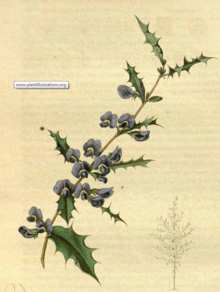Hovea chorizemifolia
Hovea chorizemifolia, commonly known as the holly-leaved hovea, is a shrub in the family Fabaceae, native to the south-west of Western Australia.
| Hovea chorizemifolia | |
|---|---|
 | |
| Scientific classification | |
| Kingdom: | |
| (unranked): | |
| (unranked): | |
| (unranked): | |
| Order: | |
| Family: | |
| Genus: | |
| Species: | H. chorizemifolia |
| Binomial name | |
| Hovea chorizemifolia | |
Description
The erect slender and prickly shrub typically grows to a height of 0.1 to 0.6 metres (0 to 2 ft)[1] The large evergreen foliage of the plant is similar to that of the holly tree.[2] The species has purple or blue flowers that appear between May and October in its native range.[1]
Taxonomy
The species was first formally described by the botanist Augustin Pyramus de Candolle, in 1825 in the work Prodromus Systematis Naturalis Regni Vegetabilis. The classification of the species has been revised many times including by Robert Sweet in 1827 as Plagiolobium chorizemifolium in Flora Australasica and as Hovea chorozemaefolia by John Lindley in 1832 in Edwards's Botanical Register.[3]
The species epithet, chorizemifolia, derives from Chorizema and the latin, folium, meaning leaf and thus means leaves resembling those of Chorizema.[4]
Distribution
It occurs on hills, breakaways and granite outcrops in the South West, Peel and Great Southern regions of Western Australia where it grows in sandy and gravelly lateritic soils[1] and often as part of Jarrah forest communities.[2]
References
- "Hovea chorizemifolia". FloraBase. Western Australian Government Department of Parks and Wildlife.
- "Plant of the Month - July" (PDF). Blackwood Basin Group. Retrieved 25 October 2018.
- "Hovea chorizemifolia DC". Atlas of Living Australia. Global Biodiversity Information Facility. Retrieved 3 January 2017.
- Plant Illustrations: Hovea chorizemifolia. Retrieved 24 October 2018.